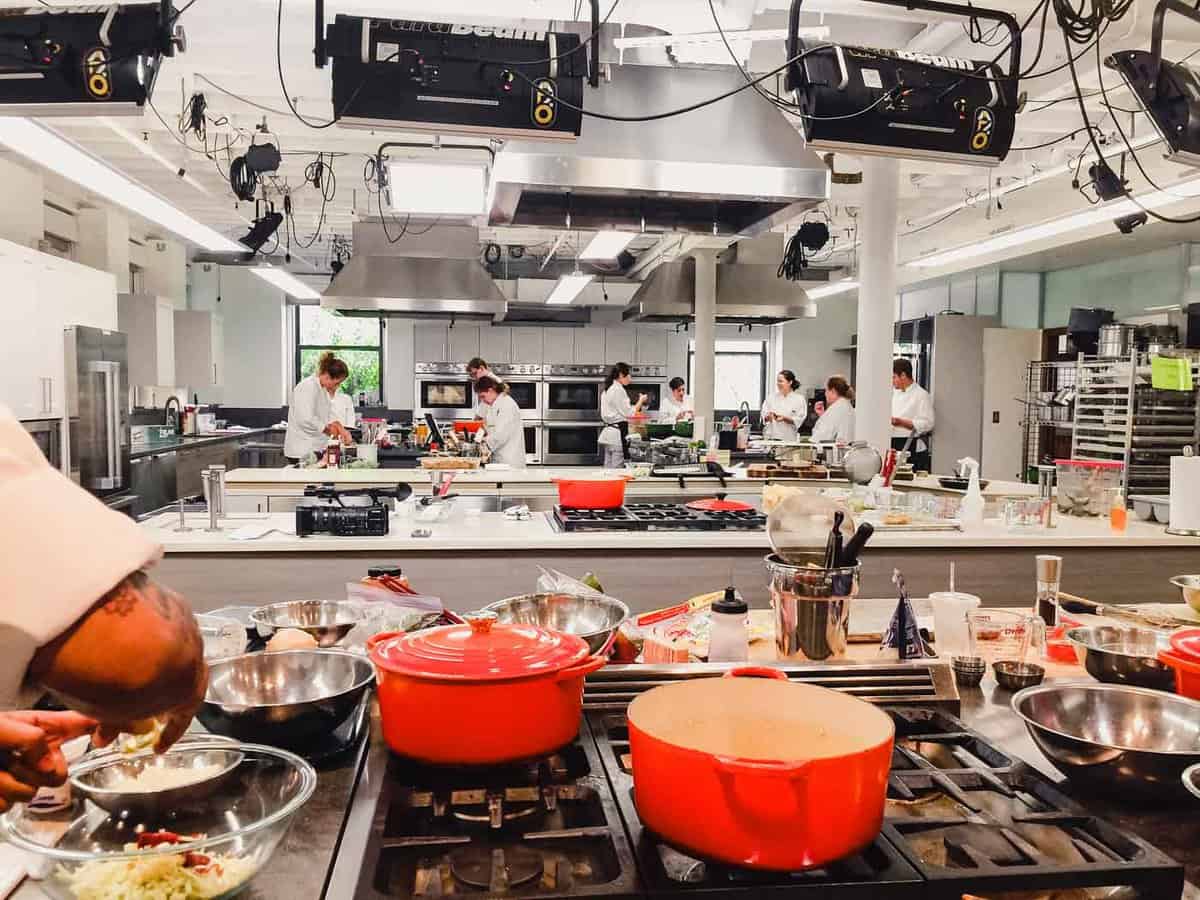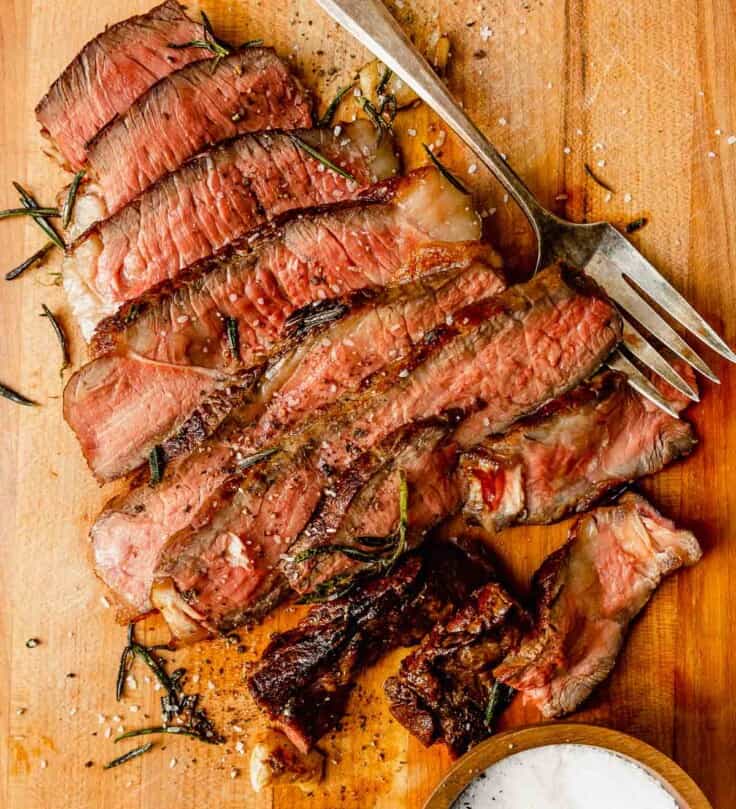This Reverse Sear Steak Recipe is the ultimate foolproof method of cooking a thick cut of steak perfectly every single time. After learning this method in culinary school, there is no other way I would cook it at home, it’s easy, simple, and melts in your mouth. Impress your family and friends with all of these chef tips for cooking the best steak.
What is a Reverse Sear Steak?
Reverse searing is a method of cooking meat, typically steak, by slow roasting it at a low temperature until it reaches the desired internal temperature, and then searing it quickly at a high temperature to create a flavorful crust on the outside. This method is in contrast to traditional searing, which involves searing the meat at a high temperature first and then finishing it in the oven.
The low temperature cooking method can be in the oven or indirect heat on the grill. The searing step to finish the steak can be stovetop in a cast iron pan or over direct heat on the grill.
The reverse sear was developed when sous vide cooking became popular in the early 2000s. The sous vide machine was too expensive at the time, and using the oven produced similar results for people at home. It’s been one of the best steak cooking methods ever since.
The reverse sear method is ideal for cooking steak as it allows for greater control over the cooking process and results in a steak that is more evenly cooked through. The end result is a tender, juicy and perfectly cooked steak with crisp golden crust.
This cooking method is also oftentimes how restaurants prepare their larger cuts of steak for a crowd. It’s great to cook the beef in the oven in advance, then sear on the stovetop when ready to serve for a tender bite.
Steak recipes are one of our favorites to develop in the kitchen. You can never go wrong with a delicious top sirloin, rich ribeye, celebratory filet mignon with creamy sauce, steak tacos, steak salad, or an Italian sandwich.
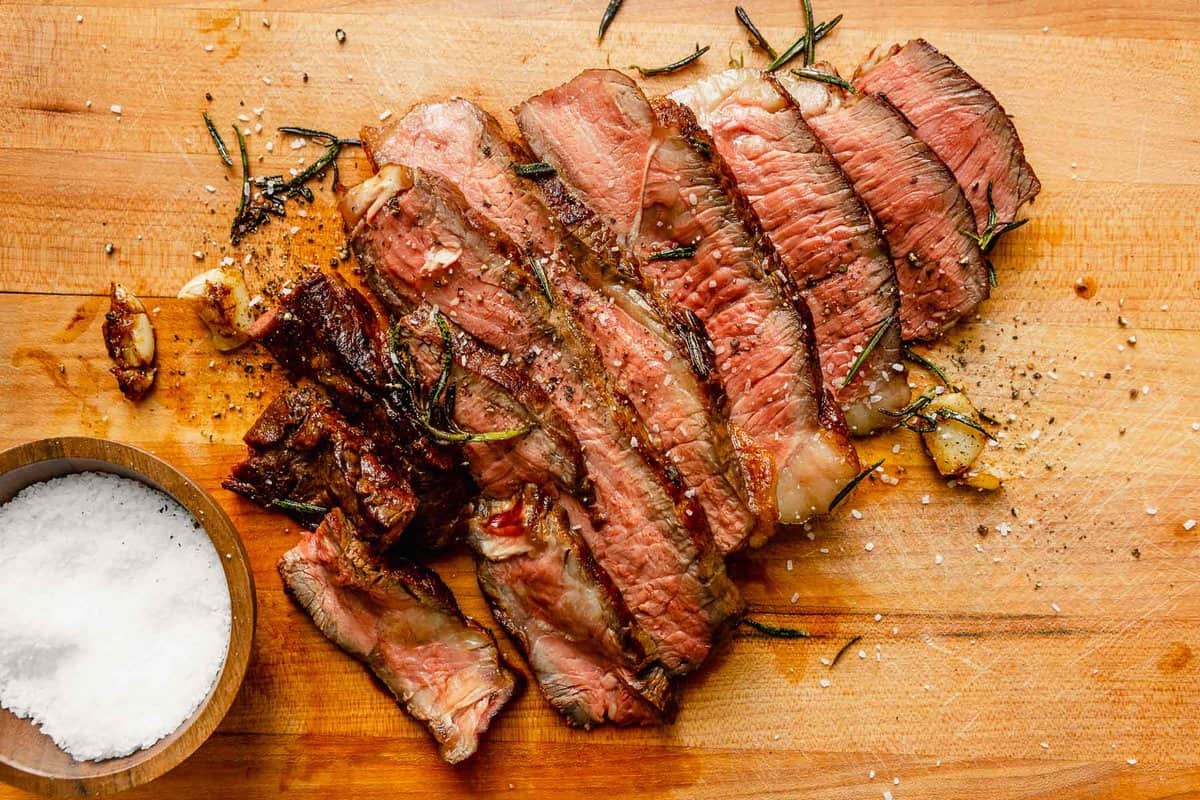
Benefits of Reverse Searing Steak
Reverse searing steaks has a lot of benefits. For one it creates a better browned exterior, encourages even cooking, and results in juicier and more tender beef.
- Encourages even cooking throughout (no hot or cold spots)
- Because it’s a slow cooking process it gives you more control over doneness
- Juicier meat
- A wonderfully golden and savory crust
- Similar method to sous vide, without requiring the equipment
- The drippings in the pan can be used to make a sauce
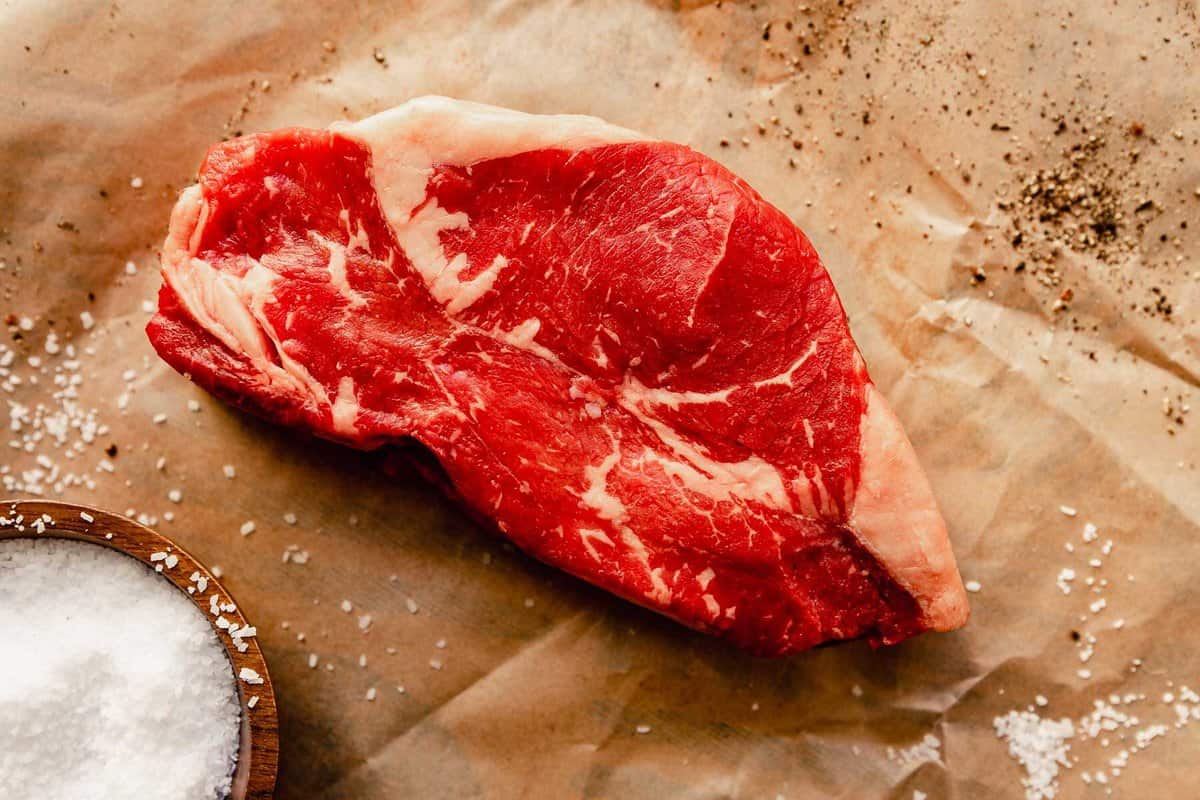
Best Cut of Beef for Reverse Sear
When you are looking to reverse sear a steak, it’s important to buy the right cut of meat. We recommend going to a nice butcher shop and asking for a steak that’s at least 1½– to 2-inches thick. Some examples include a NY strip, ribeye, porterhouse, T-bone, or tri-tip.
Ask the butcher to give you a cut of beef that has nice marbling. This means that there’s cartilage throughout the the protein that dissolves and melts into the beef as it’s cooked in the oven making it fork tender in texture.
You’ll want to avoid thin cuts of steak, like flank or skirt. These are best cooked quickly on the stove rather than with a reverse sear method. More questions about cuts of steak to buy? We have our expert guide that’s great to refer to.
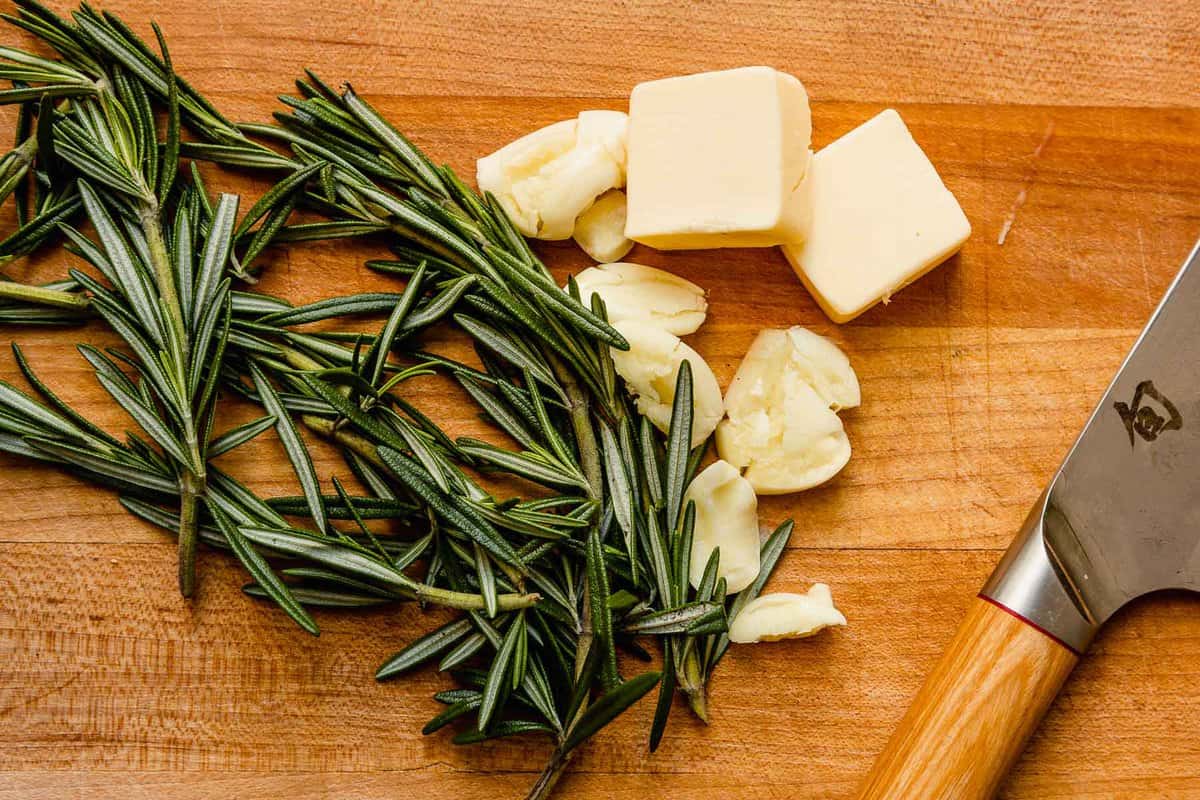
Ingredients
- Steak: look for steaks that are thick—at least 1 ½ inches thick or up to 2 inches thick. I like a NY strip, ribeye, porterhouse, T-bone, tri-tip, or filet mignon.
- Kosher salt and black pepper: I prefer Morton kosher salt for its large flake size, but any kosher salt will do.
- Butter: I prefer to use unsalted butter since the steak is already very well seasoned.
- Oil: you’ll need a couple tablespoons of neutral high-heat cooking oil such as canola or avocado oil.
- Optional: a couple of smashed garlic cloves and a few sprigs of fresh rosemary can be added to the cast-iron skillet during searing for added flavor.
Chef’s Tip
If you have the time prior to cooking, let the steaks rest for at least 2 hours (or up to 12) in the refrigerator set on a wire rack uncovered. This tenderizes the meat and makes it juicier by encouraging it to hold onto moisture.
How to Reverse Sear Steak
- Season the Steak. Since we’re using thick cuts of beef, it’s important to season the them well with kosher salt. (Wait to season with pepper until after or it will burn during the searing step.) We recommend seasoning each steak with 1 teaspoon of kosher salt.
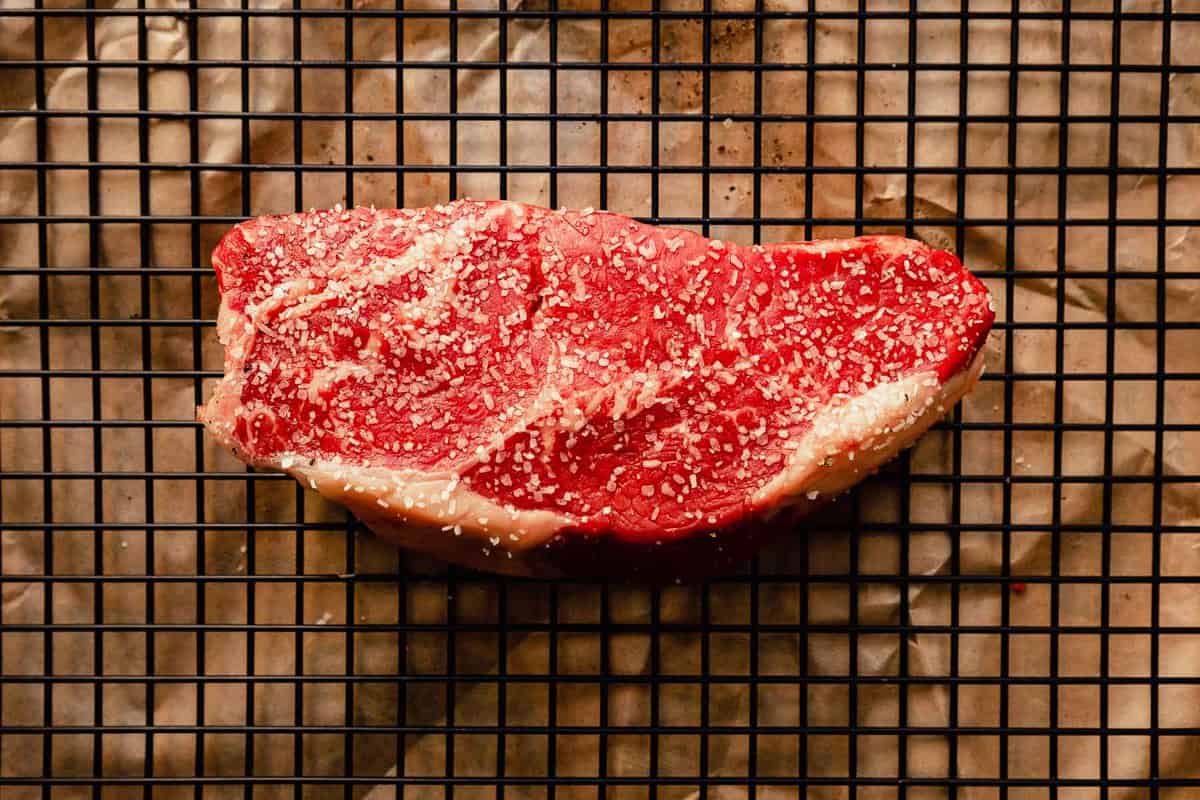
- Prepare the Steak for Roasting. Set the steaks on a wire rack set inside a baking sheet.
- If you have the time prior to cooking, let the steaks rest for at least 2 hours (or up to 12) in the refrigerator set on a wire rack uncovered. This tenderizes the meat and makes it juicier by encouraging it to hold onto moisture.
- Preheat the oven. Heat the oven to 200ºF or as low as it will go. The lower the temperature, the longer the cook time and vice versa.
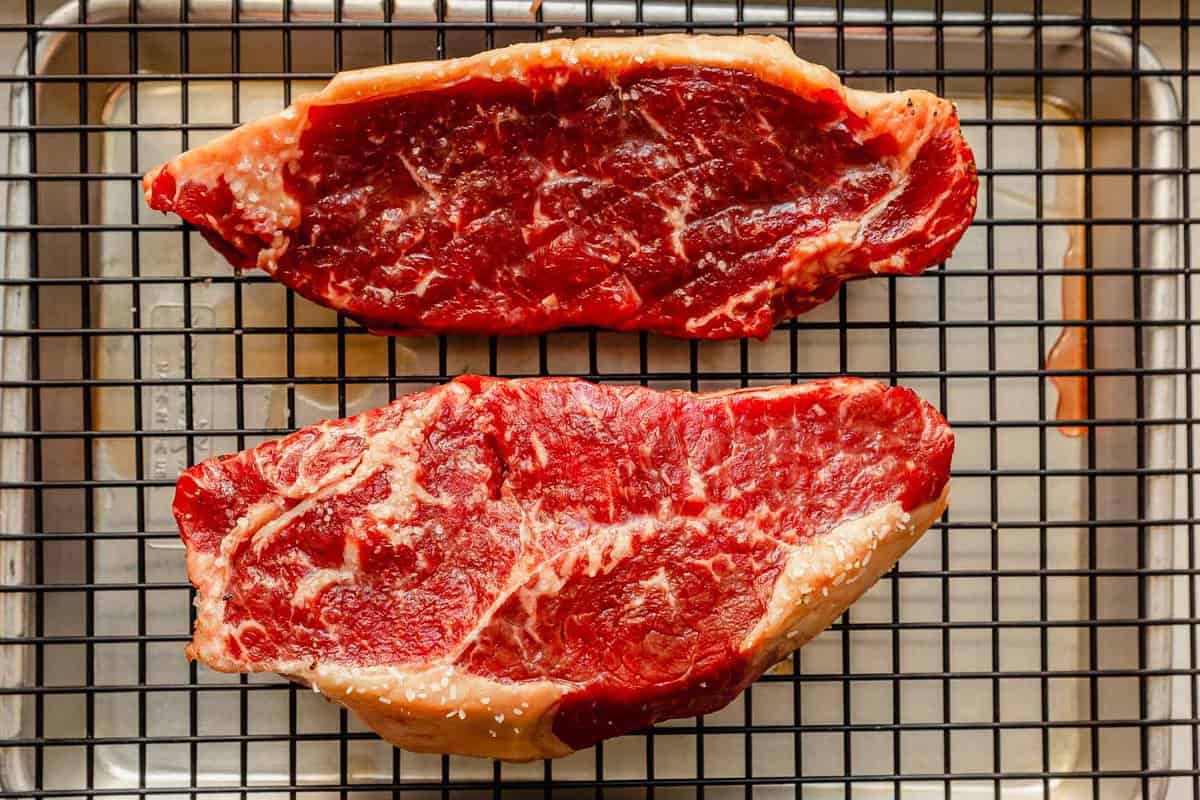
- Slow roast the steaks. Place them in the oven and cook for 15 minutes. After 15 minutes, start checking the internal temperature using an instant-read thermometer about every 5 minutes until steaks have reached:
- 100–105°F (38–41°C) for rare
- 105–115°F (41–46°C) for medium-rare
- 115–125°F (46–52°C) for medium
- 125–135°F (52–57°C) for medium-well
- 135–140ºF (57–63ºC) for well-done
This will not be the final temperature of your steak—pull it from the oven about 15 to 20ºF below the desired temperature.
- Preheat a large cast iron skillet over high heat. Add the butter and oil (and garlic and rosemary, if using) and swirl to coat.
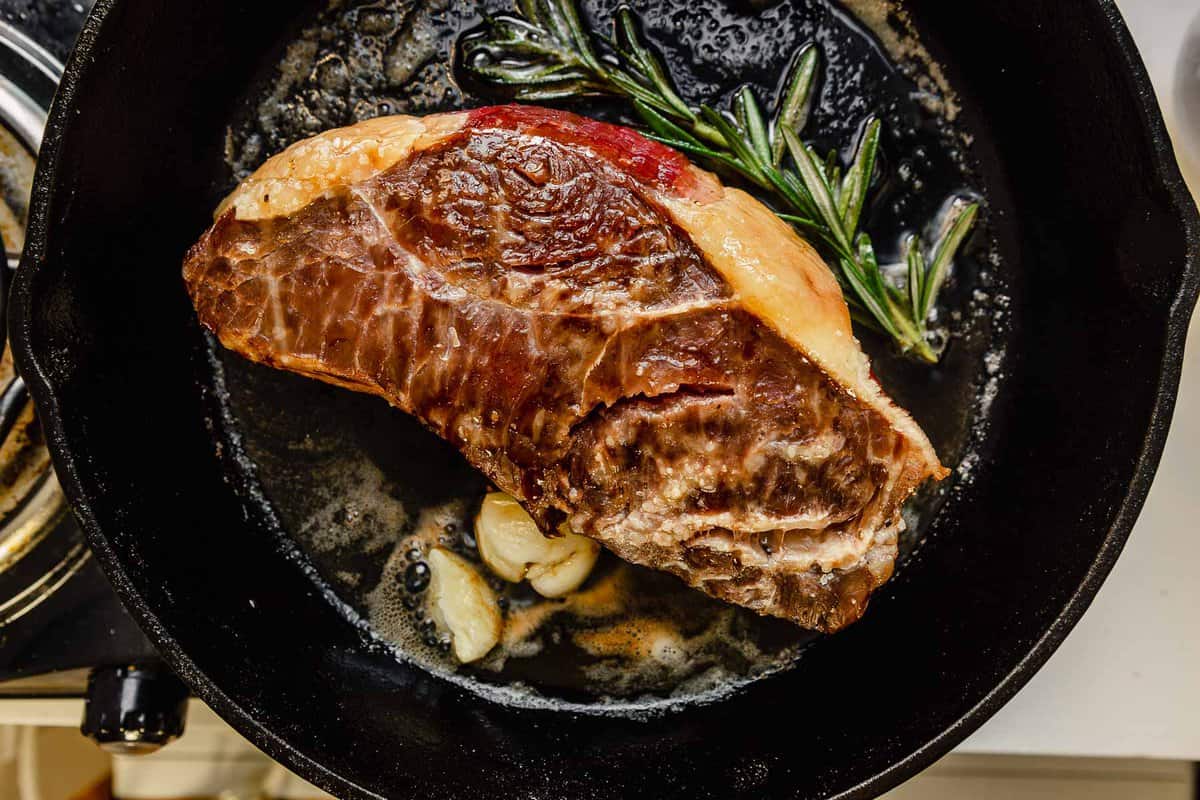
- Sear the steaks until a golden crust is formed on each side and desired doneness is reached, about 1 ½ minutes per side.
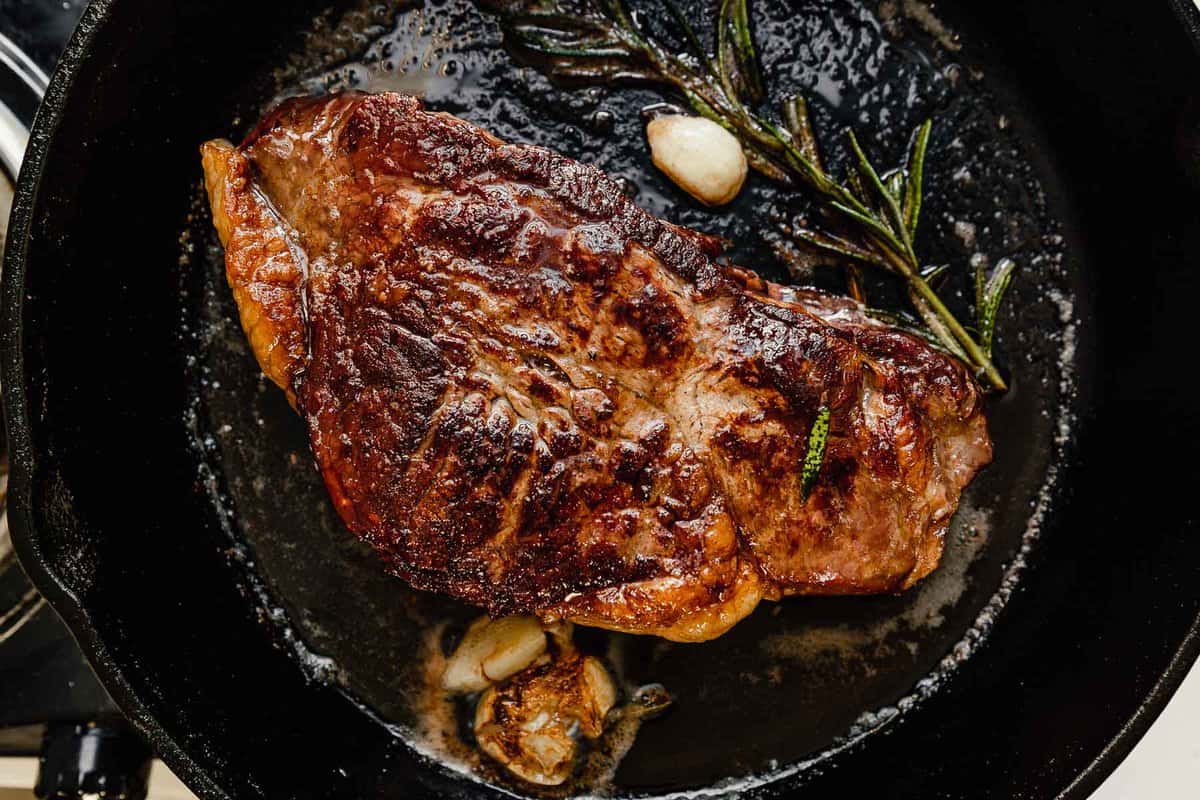
- Allow the steak to rest. Since the steak was cooked low and slow, it’s not necessary to rest it long before slicing into it. We recommend letting it rest just 2 minutes before slicing and immediately enjoying.
It should be notes, the USDA recommends cooking beef to a minimum internal temperature of 145ºF (63ºC).
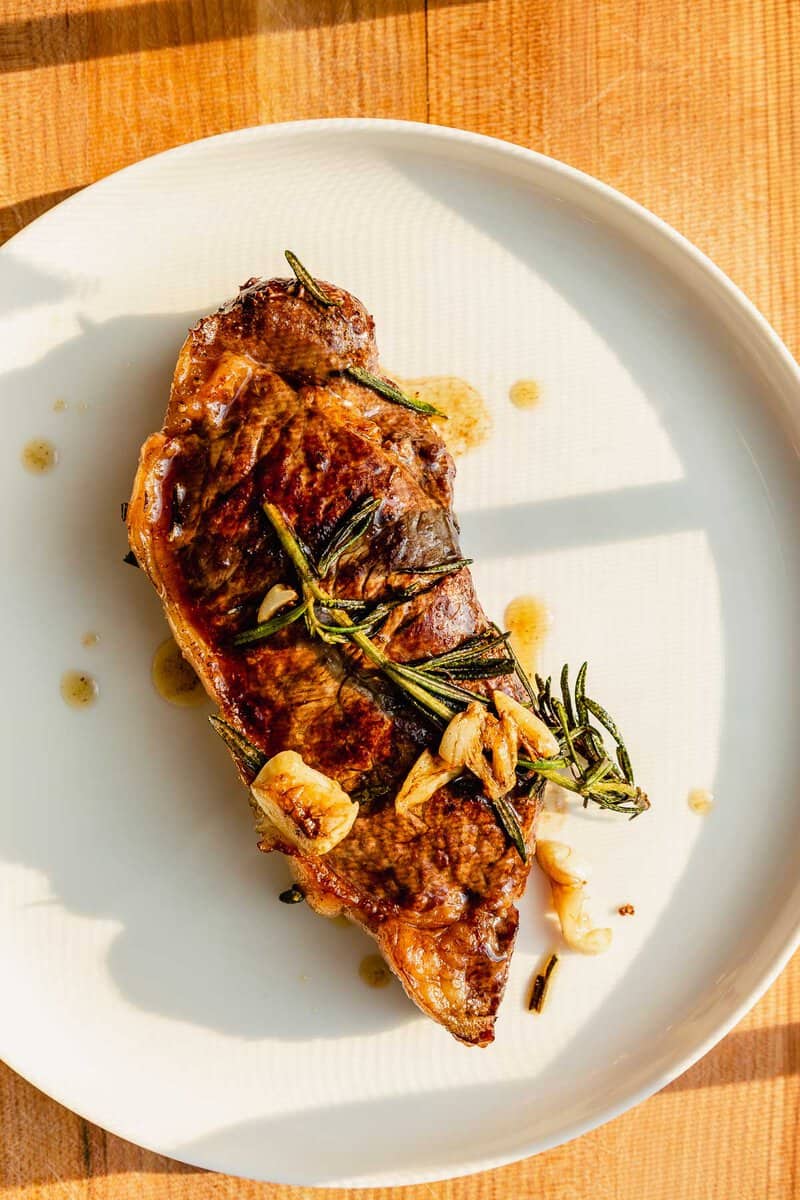
Temperature Guidelines
| Doneness | Roast to Internal Temp | Sear to internal temp |
|---|---|---|
| Rare | 100–105°F (38–41°C) | 120–125ºF (49–52ºC) |
| Medium-rare | 105–115°F (41–46°C) | 125–130ºF (52–54ºC) |
| Medium | 115–125°F (46–52°C) | 135–140ºF (57–60ºC) |
| Medium-well | 125–135°F (52–57°C) | 145–150ºF (63–65ºC) |
| Well-done | 135–140ºF (57–63ºC) | 155–160ºF (68–71ºC) |
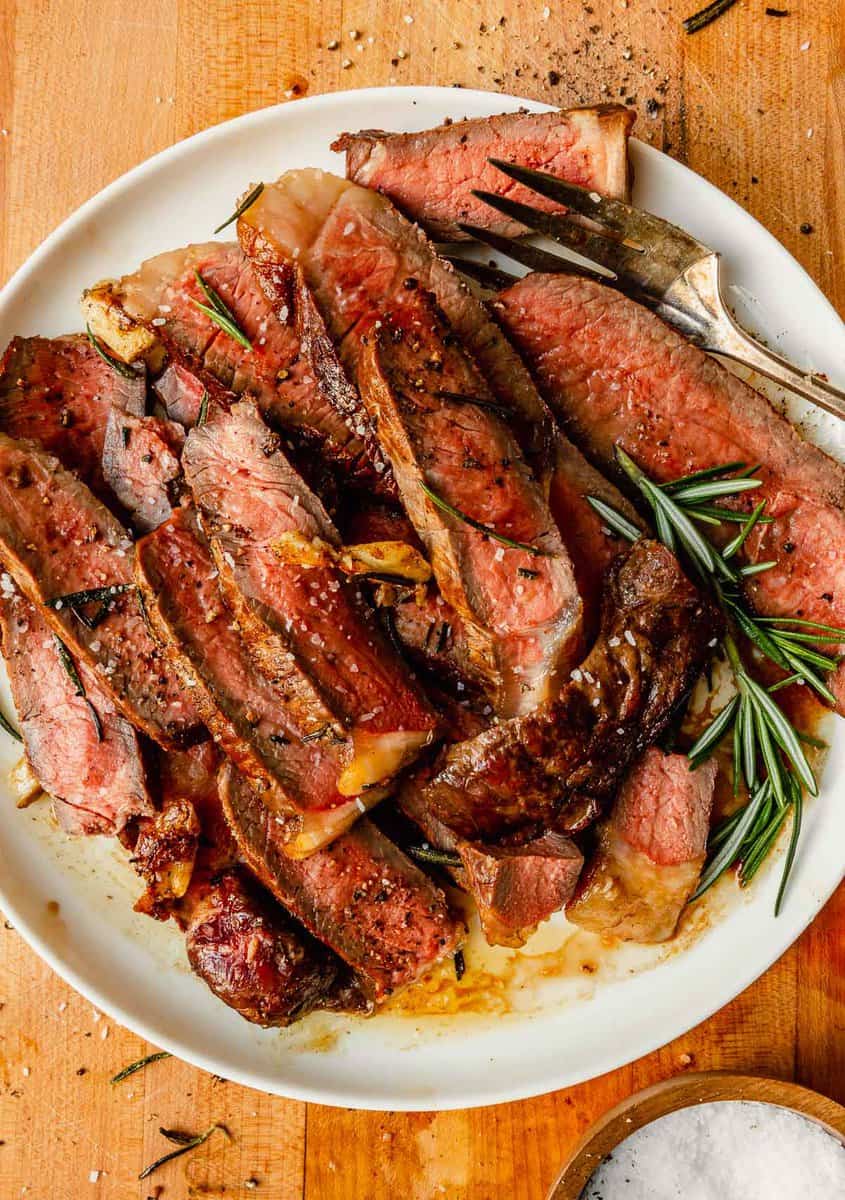
Expert Tips
- This method works best for thick-cut steaks. Choose a steak that’s at least 1 ½ inches thick (but no more than 2 inches thick). Thinner cuts are better for high-heat cook methods like stove top searing or grilling.
- Season the steak generously with kosher salt prior to cooking. Since you’re cooking very large, thick steaks, don’t be afraid to be heavy handed with the salt. Steak can handle it.
- If you have the time prior to cooking, let the steaks rest in the refrigerator for 2–12 hours uncovered. This seasons the meat throughout and makes for a more tender and juicy bite.
- Avoid overcooking the steak by removing it from the oven when a thermometer registers 15ºF below your desired temperature. Finishing the steak in a cast-iron skillet will get the steak up to temp.
- Sear the steak in a piping hot cast-iron skillet for just 1 ½ minutes per side. A short stint is key for preventing overcooking while achieving a golden brown crust.
Storage and Make Ahead Tips
For the Fridge: Any leftovers can be stored in an airtight container in the fridge for up to 4 days.
For the Freezer: Wrap any leftover pieces in plastic wrap then place in the freezer for 1 to 2 months. Thaw at room temperature for 1 to 2 hours or in the fridge overnight. You can also freeze raw steak in the same way and then proceed to cook.
To Reheat: We have a whole guide to reheating leftover steak! We recommend bringing the steak to room temperature then searing in a pan for about a minute per side until warm.
For Make Ahead: Season the steak with salt and keep in the fridge uncovered for 2 to 12 hours before making. This naturally seasoning and tenderizes the beef by drawing out excess moisture, making the meat even more buttery after cooked.
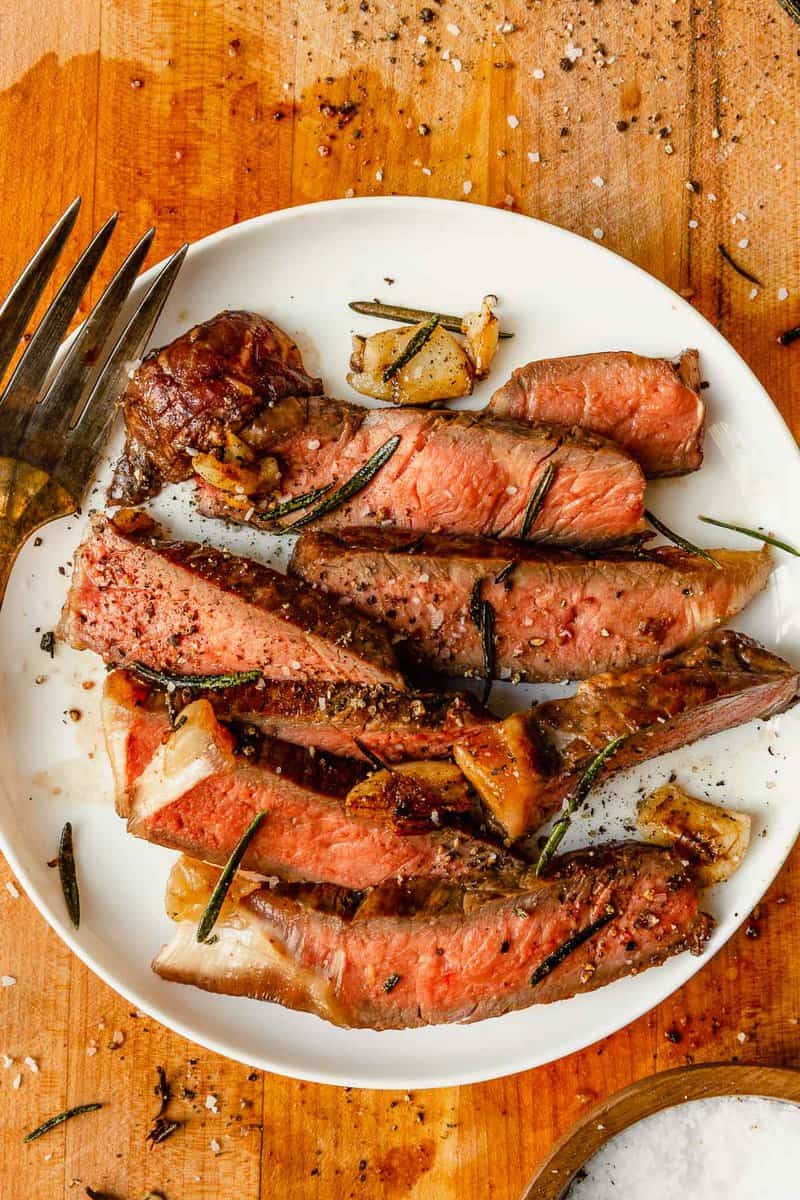
What to Serve with Reverse Sear Steak
A reversed seared steak is absolutely delicious on its own. We have some other easy recipe and ingredient recommendations for serving.
Simply serve with some freshly cracked black pepper and horseradish on the side. Enjoy with a garden salad, Caesar salad, or simple butter lettuce salad. If you want to serve the steak in something, slice it thin and make steak tacos, a steak sandwich, or a steak salad.
FAQs
It depends on what you’re going for with your steak. If you want every single bite of the steak to be the same exact doneness, then sous vide is the best for that. If you want an evenly-cooked steak with a crisp, golden crust, then reverse searing is the best method.
If your steak is an inch or less thick, reverse searing will be tricky, but it’s doable. Roast the steak in the oven at the lowest temperature your oven will heat to. Start checking the internal temperature after 8 minutes of cooking and pull it from the oven according to your desired doneness (see the table above).
The method for reverse searing a top sirloin is the same as it would be for NY strip, ribeye, or filet mignon. Follow the instructions in our recipe card for reverse searing a top sirloin.
If you can’t get a good sear on your steak it’s likely one of the following: there is too much moisture on the surface of the steak (pat it dry before searing), the skillet is not hot enough, or you need some fat (butter or oil) in the skillet.
Yes, you can cook steak full in the oven without searing it. In that case, continue to cook the steak in the oven until the desired internal temperature is reached.
In order to properly sear steak you need some kind of fat in the skillet. If you don’t want to use oil, use butter.
More Steak Recipes
- Tacos al Carbón: These grilled steak tacos with charred scallion salsa are the perfect al fresco meal.
- How to Cook Skirt Steak and How to Cook Top Sirloin. Both are extensive guides on how to cook these cuts in a variety of different ways.
- Steak and Eggs. Our version of this classic breakfast features quick pickled vegetables and a sweet-spicy gochujang sauce.
- Best way to reheat steak. Or check out this extensive list of leftover steak recipes.
Reverse Seared Steak Recipe
Description
Ingredients
- 2 thick-cut beef steaks, at least 1 ½ inches thick or up to 2 inches thick, such as a NY strip, ribeye, porterhouse, T-bone, tri-tip, or filet mignon
- Kosher salt and black pepper
- 2 tablespoons unsalted butter
- 2 tablespoons avocado oil or vegetable oil
- 4 large cloves garlic, smashed, optional
- 2 sprigs fresh rosemary, optional
Instructions
- Season steaks all over with salt (at least 1 teaspoon salt per steak).
- Set steaks on a wire rack set inside a rimmed baking sheet. If you have the time, refrigerate steaks, uncovered, at least 2 hours or up to 12 hours. If you don’t have time, skip this step and move on to step 3.
- Heat oven to 200°F (93ºC). (Or as low as your oven goes. If it’s higher than 200ºF the process will take longer).
- Cook steaks in oven until an instant-read thermometer registers 105°F (41°C) for rare, 115°F (46°C) for medium-rare, 125°F (52°C) for medium, or 135°F (57°C) for medium-well. About 20 minutes for rare and up to 40 minutes for medium-well. Keep an eye on internal temperature—a lot of factors can impact cooking time.
- About 5 minutes before steaks come out of oven, heat a large cast-iron skillet over high heat until nearly smoking. Once steaks are removed from oven, add 2 tablespoons butter and 2 tablespoons oil to hot skillet; swirling to melt butter and coat skillet.
- Add steaks, garlic, and rosemary (if using) to skillet and cook until each side is well-browned, about 1 ½ minutes per side.
- Using tongs, hold steaks upright on their sides to sear.
- Transfer steaks to a cutting board and let rest 2 minutes. Slice and enjoy immediately.
Instructions for Cooking on Grill
- For a charcoal grill, fill a chimney full of charcoal. When all charcoal hot and covered with ash, pour out and spread coals evenly over half of coal grate. Set cooking grate in place, cover grill, and preheat 5 minutes.
- For a gas grill, set half burners to high heat.
- Brush grill grate with oil.
- Set steaks on cooler side of grill and let cook uncovered, turning occasionally, until an instant-read thermometer registers 105°F (41°C) for rare, 115°F (46°C) for medium-rare, 125°F (52°C) for medium, or 135°F (57°C) for medium-well. Keep an eye on the internal temperature—a lot of factors can impact cooking time.
- To sear on grill, transfer steaks to a plate or platter. For a charcoal grill, build up biggest fire possible. If using a gas grill, turn all burners to high heat; preheat grill for 3 minutes.
- Return steaks to hottest part of grill and cook, turning frequently, until crisp and charred all over, about 2 minutes total. Let rest 2 minutes then serve.
- To sear in cast-iron, about 5 minutes before steaks come off grill, place a large cast-iron skillet on hot side of grill. Once steaks are removed from grill, add 1 tablespoons butter and 1 tablespoon oil to hot skillet; swirling to melt butter and coat skillet.
- Add steaks, garlic, and rosemary (if using) to skillet and cook until each side is well-browned, about 1 ½ minutes per side.
- Using tongs, hold steaks upright on their sides to sear. Transfer steaks to a cutting board and let rest 2 minutes. Slice and enjoy immediately.
Video
Notes
Nutrition
This post is written and created in partnership with the Iowa Beef Council. As always the thoughts, opinions, recipe, photos and content are all my own.
Again, we would like to note, the USDA recommends cooking beef to a minimum internal temperature of 145ºF (63ºC).
